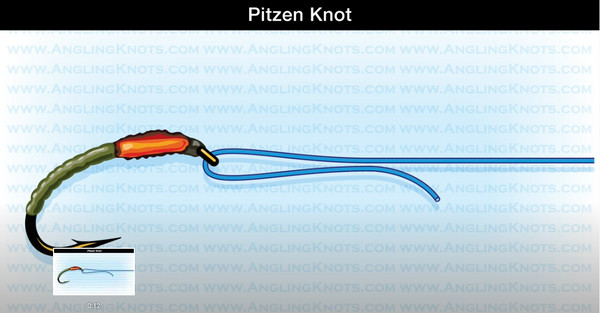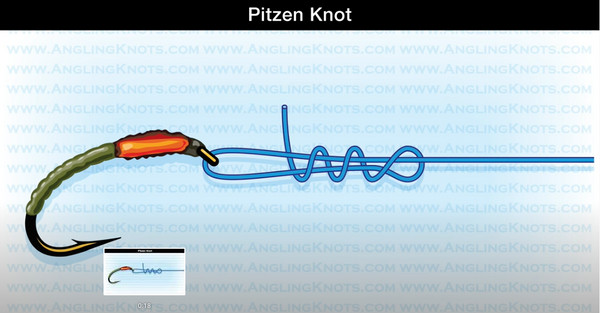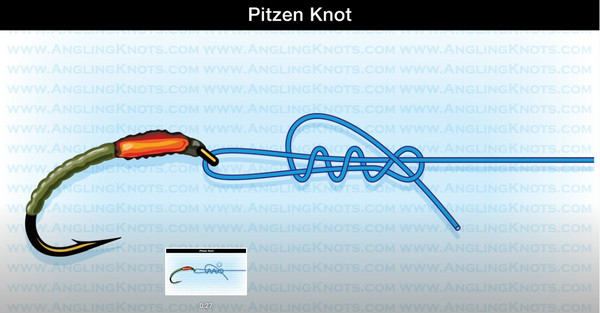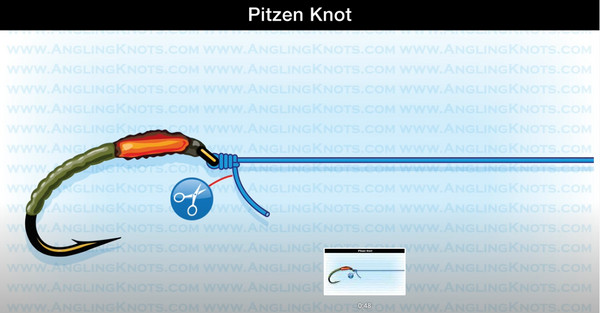Tying a fly onto your tippet doesn’t have to be a daunting task; mastering a reliable knot is key for a successful day on the water, and flyermedia.net is here to guide you. The Pitzen Knot, also known as the Eugene Bend or 16-20 knot, offers exceptional strength and simplicity, ensuring your fly stays secure and presentation remains flawless. Learn how to improve your fly fishing skills, and elevate your angling experience with fly tier tips, improved knot strength, and perfect presentation by exploring flyermedia.net.
1. Understanding the Importance of a Strong Knot
Choosing the right knot is crucial in fly fishing. A weak knot can lead to lost fish, wasted time, and frustration. Strong knots like the Pitzen Knot ensure that your fly stays connected to the tippet, even when battling larger fish.
1.1 Why Knot Strength Matters
The strength of your knot directly impacts your ability to land fish. A knot that retains a high percentage of the line’s breaking strength minimizes the risk of failure under pressure. Selecting the strongest knot will reduce the risk of losing fish, prevent gear damage, and improve the overall fishing experience.
1.2 Common Knot Failures
Many anglers experience knot failures due to improper tying techniques or choosing the wrong knot for the line type. Common issues include:
- Slippage: Knots that aren’t tightened properly can slip, causing the line to separate.
- Over-tightening: Excessive force can weaken the line at the knot point.
- Friction: Heat generated during tightening can damage the line.
- Incorrect Knot Selection: Some knots are not suitable for certain line materials or fishing conditions.
1.3 The Pitzen Knot Advantage
The Pitzen Knot stands out due to its high strength retention, ease of tying, and reliability in various conditions. It’s designed to distribute stress evenly, reducing the likelihood of failure. Tying this knot properly will maximize strength and improve your chances of a successful catch.
2. Introducing the Pitzen Knot
The Pitzen Knot, also known as the Eugene Bend or the 16-20 knot, is a reliable and strong knot for attaching a fly to a tippet. Credited to Mr. Edward Pitzenbauer of Germany, this knot is celebrated for its simplicity and exceptional strength. Fly anglers in the 16-20 club even used this knot to catch a sixteen-pound salmon with a size #20 fly.
2.1 Historical Significance
The Pitzen Knot has a rich history, with variations known by different names across the angling community. Lefty Kreh, a renowned fly fishing expert, referred to it as the Fisherman’s Knot, noting its prevalence since the 1950s.
2.2 Key Features
The Pitzen Knot is favored for several reasons:
- High Strength: Retains over 95% of the line’s breaking strength.
- Simplicity: Easy to learn and tie, even in challenging conditions.
- Reliability: Performs consistently well with various line types.
- Tactile Feedback: Gives a noticeable “pop” when tied correctly.
2.3 Comparing the Pitzen Knot to Other Knots
Compared to other popular knots like the Clinch Knot (one of the weakest), the Pitzen Knot provides superior strength and reliability. While the San Diego Jam Knot is a derivative, the Pitzen Knot’s direct approach simplifies the tying process without sacrificing strength.
3. Step-by-Step Guide to Tying the Pitzen Knot
Follow these detailed instructions to master the Pitzen Knot and ensure a secure connection between your fly and tippet.
3.1 Materials Needed
- Tippet line
- Fly
- Scissors or nippers
3.2 Detailed Instructions
- Thread the Line: Pass the tippet line through the eye of the fly hook.
 Thread the line through the eye of the hook for the Pitzen knot
Thread the line through the eye of the hook for the Pitzen knot - Form a Loop: Loop the tag end back under the standing part of the line, creating a small loop.
- Wrap the Line: Hold the loop between your thumb and index finger. Wrap the tag end around the two parallel lines (the standing line and the tag end itself) three times, working back towards the eye of the hook.
 Wrap the tag end of the tippet around the standing line multiple times
Wrap the tag end of the tippet around the standing line multiple times - Pass Through the Loop: Pass the tag end back through the small loop you initially created and are holding with your finger.
 Pass the tag end back through the loop held by your finger
Pass the tag end back through the loop held by your finger - Tighten the Knot: Moisten the knot with water or saliva to lubricate it. Slide the knot down to the hook eye using your fingertips, not by pulling on the standing line.
 Tighten the Pitzen knot down onto the standing line
Tighten the Pitzen knot down onto the standing line - Final Tightening: Once the knot is in position at the hook eye, pull the standing line tight. You should feel a distinct “click” as the knot seats properly. The tag end should exit the front of the knot almost parallel with the standing line.
 Check that the tag end exits parallel to the standing line after tightening
Check that the tag end exits parallel to the standing line after tightening - Trim the Tag End: Use scissors or nippers to trim the excess tag end, leaving about 1/8 inch.
3.3 Visual Aids and Video Tutorials
For a clearer understanding, refer to visual aids such as diagrams and video tutorials. Websites like flyermedia.net often provide detailed videos and step-by-step images to guide you through the process.
3.4 Common Mistakes to Avoid
- Not lubricating the knot: Dry knots can weaken the line.
- Pulling too hard during tightening: Can cause friction and damage the line.
- Skipping the “click” check: Ensures the knot is seated correctly.
- Not trimming the tag end: A long tag end can interfere with casting.
4. Tips and Tricks for Mastering the Pitzen Knot
Mastering the Pitzen Knot requires practice and attention to detail. These tips and tricks can help you improve your knot-tying skills.
4.1 Practice Regularly
Consistent practice is key to mastering any knot. Practice tying the Pitzen Knot at home, so you’re prepared on the water.
4.2 Use the Right Tools
- Nippers: Sharp nippers ensure a clean cut when trimming the tag end.
- Knot-Tying Tools: These tools can help tighten and seat the knot, especially with smaller flies or in cold conditions.
- Magnifying Glasses: Helpful for tying knots with fine tippet.
4.3 Adjusting for Different Line Types
The Pitzen Knot works well with various line types, but adjustments may be needed:
- Fluorocarbon: Known for its low visibility and abrasion resistance, requires careful lubrication.
- Monofilament: A versatile option, easy to work with but can stretch.
- Braided Line: Requires extra wraps for better grip; consider a San Diego Jam Knot variant.
4.4 Testing Your Knot
Before casting, test your knot by pulling on the fly and standing line. This ensures the knot is secure and properly tied. Regularly check your knot for signs of wear or damage, especially after catching a fish or snagging on debris.
5. The Science Behind the Pitzen Knot’s Strength
Understanding the mechanics of the Pitzen Knot can help you appreciate its reliability. The knot’s design evenly distributes stress along the line, minimizing weak points.
5.1 Stress Distribution
The Pitzen Knot’s wrapping technique ensures that the force is spread across multiple points, reducing the strain on any single section of the line. This even distribution minimizes the risk of breakage.
5.2 Line Material Properties
Different line materials react differently under stress. Fluorocarbon, for example, is strong but can be brittle if not lubricated properly. Monofilament stretches, which can affect knot tightness over time.
5.3 Impact of Knot Design
The Pitzen Knot’s design avoids sharp bends and tight angles that can weaken the line. Its smooth, gradual curves maintain more of the line’s original strength.
6. When to Use the Pitzen Knot
The Pitzen Knot is versatile and suitable for various fly fishing scenarios. Understanding when to use it can enhance your fishing success.
6.1 Ideal Fishing Conditions
The Pitzen Knot excels in situations where strength and reliability are paramount:
- Large Fish: When targeting larger species like salmon or steelhead.
- Heavy Cover: Fishing around structures like rocks or trees.
- Strong Currents: Where the fly is subject to significant drag.
6.2 Fly Selection
The Pitzen Knot works well with a variety of fly types:
- Dry Flies: Securely attaches dry flies without hindering their buoyancy.
- Nymphs: Provides a strong connection for fishing nymphs near the bottom.
- Streamers: Handles the aggressive strikes often associated with streamer fishing.
6.3 Line Weight Considerations
The Pitzen Knot performs consistently across different line weights, making it a reliable choice regardless of the tippet size. However, remember that lighter lines require more delicate handling during the tying process.
7. Alternatives to the Pitzen Knot
While the Pitzen Knot is an excellent choice, several alternative knots can also be used for attaching a fly to a tippet.
7.1 Improved Clinch Knot
The Improved Clinch Knot is a common choice, but it’s weaker than the Pitzen Knot. It is easier to tie but may not be suitable for heavier fish or challenging conditions.
7.2 Orvis Knot
The Orvis Knot is another strong option, offering good strength retention and ease of tying. It’s a versatile knot that works well with different line types.
7.3 Davy Knot
The Davy Knot is one of the fastest knots to tie, making it ideal for situations where speed is essential. However, it may not be as strong as the Pitzen Knot.
7.4 Choosing the Right Alternative
Consider the following factors when selecting an alternative knot:
- Strength: How much weight can the knot withstand?
- Ease of Tying: How quickly and easily can you tie the knot?
- Line Type: Is the knot compatible with your line material?
- Fishing Conditions: Does the knot perform well in your target environment?
8. Enhancing Your Fly Fishing Experience with flyermedia.net
flyermedia.net is your ultimate resource for all things fly fishing, offering a wealth of information, tips, and resources to enhance your angling experience.
8.1 Expert Tips and Tutorials
Access a wide range of expert tips and tutorials on knot tying, fly selection, casting techniques, and more. Learn from experienced anglers and improve your skills.
8.2 Gear Reviews and Recommendations
Stay informed about the latest fly fishing gear with detailed reviews and recommendations. Find the best equipment for your needs and budget.
8.3 Fishing Destination Guides
Explore premier fishing destinations around the world with comprehensive guides. Discover the best locations for your next fly fishing adventure.
8.4 Community Forums
Connect with other anglers in our community forums. Share your experiences, ask questions, and learn from fellow enthusiasts.
9. Real-World Applications and Success Stories
The Pitzen Knot has proven its worth in countless fishing scenarios. Here are a few real-world applications and success stories.
9.1 Case Study 1: Landing a Trophy Trout
John, an avid fly fisherman, used the Pitzen Knot to land a 28-inch brown trout in a challenging river environment. The knot held strong despite the fish’s powerful runs and the rocky terrain.
9.2 Case Study 2: Battling Strong Currents
Sarah, a seasoned angler, relied on the Pitzen Knot while fishing in fast-moving currents. The knot’s reliability ensured her fly stayed connected, allowing her to catch multiple fish throughout the day.
9.3 Testimonials from Anglers
“I’ve been using the Pitzen Knot for years, and it has never failed me. It’s easy to tie, and I have complete confidence in its strength.” – Mike, Fly Fishing Enthusiast
“The Pitzen Knot is my go-to knot for streamer fishing. It holds up against aggressive strikes and heavy fish.” – Emily, Professional Angler
10. Conclusion: Mastering the Pitzen Knot for Fly Fishing Success
Mastering the Pitzen Knot is a game-changer for any fly fisherman. Its strength, simplicity, and reliability make it an essential skill for anglers of all levels.
10.1 Recap of Key Benefits
- High strength retention
- Easy to learn and tie
- Reliable in various conditions
- Versatile for different line types and fly selections
10.2 Encouragement for Practice and Improvement
Take the time to practice the Pitzen Knot regularly. With consistent effort, you’ll master the technique and gain the confidence to tackle any fishing situation.
10.3 Final Thoughts on Knot Selection
Choosing the right knot is a critical aspect of fly fishing. The Pitzen Knot is an excellent option, but always consider the specific conditions and line types you’re working with. Stay informed, practice regularly, and enjoy your time on the water. Visit flyermedia.net for more expert tips, tutorials, and resources to enhance your fly fishing experience.
FAQ: Frequently Asked Questions About Tying Flies Onto Tippet
1. What is the Pitzen Knot and why is it recommended for fly fishing?
The Pitzen Knot, also known as the Eugene Bend or 16-20 knot, is a strong and reliable knot used to attach a fly to a tippet because it retains over 95% of the line’s breaking strength and is easy to tie, even in challenging conditions.
2. How does the Pitzen Knot compare to other popular fly fishing knots like the Clinch Knot?
The Pitzen Knot offers superior strength and reliability compared to the Clinch Knot, which is one of the weakest fly fishing knots because the Pitzen Knot’s design evenly distributes stress, reducing the likelihood of failure.
3. Can you provide a step-by-step guide on how to tie the Pitzen Knot?
To tie the Pitzen Knot, thread the line through the eye of the hook, form a loop, wrap the line around the standing line three times, pass the tag end through the loop, tighten the knot while moistening, and trim the tag end.
4. What are some common mistakes to avoid when tying the Pitzen Knot?
Common mistakes to avoid when tying the Pitzen Knot include not lubricating the knot, pulling too hard during tightening, skipping the “click” check to ensure proper seating, and not trimming the tag end.
5. What tools can help improve my Pitzen Knot tying skills?
Helpful tools for tying the Pitzen Knot include sharp nippers for a clean cut, knot-tying tools to help tighten and seat the knot, and magnifying glasses for tying knots with fine tippet.
6. Is the Pitzen Knot suitable for all types of fishing line?
The Pitzen Knot works well with various line types, including fluorocarbon, monofilament, and braided line, but adjustments may be needed depending on the line material because fluorocarbon requires careful lubrication, while braided line may need extra wraps.
7. In what fishing conditions is the Pitzen Knot most effective?
The Pitzen Knot is most effective in conditions where strength and reliability are paramount, such as when targeting large fish, fishing in heavy cover, or fishing in strong currents because these situations demand a secure and durable knot.
8. Can the Pitzen Knot be used with different types of flies?
Yes, the Pitzen Knot is versatile and can be used with various fly types, including dry flies, nymphs, and streamers because it provides a strong and secure connection without hindering the fly’s natural movement or buoyancy.
9. Are there alternative knots that can be used in place of the Pitzen Knot?
Alternative knots include the Improved Clinch Knot, Orvis Knot, and Davy Knot, but it’s important to consider the strength, ease of tying, line type compatibility, and fishing conditions when choosing an alternative.
10. Where can I find more resources and expert tips on fly fishing and knot tying?
You can find more resources and expert tips on fly fishing and knot tying at flyermedia.net, which offers a wealth of information, tutorials, gear reviews, and community forums to enhance your angling experience.
Are you ready to elevate your fly fishing skills? Visit flyermedia.net today for expert tips, tutorials, and gear recommendations! Unlock your potential and make every cast count. Your ultimate fly fishing experience awaits!